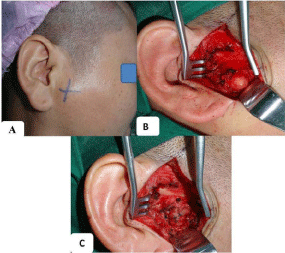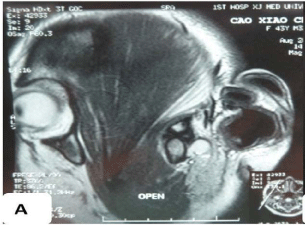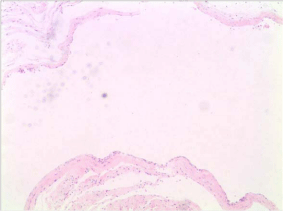Case Report
Synovial Cyst of the Temporomandibular Joint: A Case Report and Literature Review
Dwa S, Chen Q, Gong Z*, Bajracharya K and Lin Z
Department of Oral and Maxillofacial Surgery, The First Affiliated Hospital of Xinjiang Medical University, China
*Corresponding author: Zhongcheng Gong, Department of Oral & Maxillofacial Surgery, The First Affiliated Hospital of Xinjiang Medical University, Stomatology School of Xinjiang Medical University, Stomatology Research Institute of Xinjiang Province, Urumqi, 830054, Xinjiang, P. R. China
Published: 04 Jul, 2016
Cite this article as: Dwa S, Chen Q, Gong Z, Bajracharya
K, Lin Z. Synovial Cyst of the Temporomandibular Joint: A Case Report and Literature Review. Clin Surg. 2016; 1: 1046.
Abstract
Synovial cyst in the Temporomandibular joint (TMJ) is rare entity but predominant in dorsum
of the wrist, foot and knee. It develops by the increase of intracapsular pressure due to trauma,
or inflammation which causes capsular herniation or by displacement of synovial tissue during
embryogenesis. Here we report a case of synovial cyst in TMJ. A 42 year Chinese woman with synovial
cyst in right TMJ is presented. Clinical examination revealed 2cmx 2cm mass in the preauricular
region. Magnetic Resonance Imaging (MRI) showed a cystic mass with abnormal intensities in the
lateral region of the right TMJ. A preauricular approach was carried out and a surgical excision
of the cyst from the lateral surface of the TMJ capsule was completed. Histological examination
and immunohistochemical staining shown that the cyst lined by synovial cells. The clinical and
radiological follow-up (after 4 months) showed no sign of recurrence. Meanwhile, total of 20 cases
including the present case reported in the literature from 1978 to 2014 with the differential diagnosis
and management of cysts are discussed. Surgical removal is the recommended treatment. Few other
treatments like aspiration, compression of the cyst, and injection of a sclerotic agent have also been
reported but all of these are associated with high recurrence rate so not recommended.
Keywords: Synovial cyst; Temporomandibular joint; Ganglion cyst
Introduction
Cyst of temporomandibular region is rare entity. These cystic structures are of 2 types according to the presentation: 1. Synovial cysts are true cysts lined by synovial cell (synoviocytes) which produce gelatinous fluid within cystic space. It may or may not communicate with joint cavity [1]. Gaisford et al. [2] reported the first synovial cyst of the TMJ in 1969 [2]. 2. Ganglion cysts are pseudocysts lined by fibrous connective tissue, with viscoid fluid or gelatinous material and do not communicate with the joint cavity [3]. Heydt in 1977 first reported case of a ganglion cyst of TMJ. These cysts are predominantly found in the extensor surface of the wrist, the dorsal surface of foot and lateral aspect of knee [4]. In the present article, a case of synovial cyst of the TMJ is presented; meanwhile, cases reported from 1978 to 2014 are also discussed.
Case Report
A 42 years old Chinese woman reported a right preauricular painless mass 1 cm anterior to the
tragus for 2 months (Figure 1). Her medical history was unremarkable and no history of allergy,
no traumatic injury to mandible or ear was reported. She denied any previous TMJ dysfunction.
Clinical examination revealed 2cmx2cm mass in the preauricular region. The mass was smooth,
hard and no tender on palpation. No deviation of mandible when she opened her mouth and the
mass did not appear to interfere with full range of mandibular movement. NO clicking, no crepitus
or subluxation was appreciated. There was no enlarged cervical lymph node. The rest of her head
and neck examination was unremarkable. The preoperative blood biochemistry was normal. The
overlying skin was normal in color. No facial paralysis or paresis was reported.
Magnetic resonance imaging (MRI) showed a cystic mass with abnormal intensities in the
lateral region of the right TMJ (Figure 2). T1-weighted Images (WI) and T2-WI indicated lowintensity
and high-intensity areas, respectively.
Under general anesthesia, a preauricular incision on the right side was made and carried down
to the mass. A small cystic lesion of approximately 2cmx2cm was identified outside the capsule of
TMJ closely adhere with capsule, but not to the parotid gland. The mass was then dissected carefully
from the lateral surface of the TMJ capsule without breaking the capsule (Figure 1). The wound was
then sutured in layers. The postoperative course was uneventful without damage to the facial nerve.
The histological examination of the excised mass showed cyst
wall tissue, lining with simple cuboidal epithelium, colonization of
lymphocytes and plasma cells in part of the cyst wall tissue (Figure
2). The histological findings were consistent with the diagnosis of a
synovial cyst.
The clinical and radiological follow-up (after 4 months) showed
no sign of recurrence.
Figure 1
Figure 1
A 42 years woman with synovial cyst in the right TMJ. synovial
cyst in the right TMJ region measuring 1cmx1cm(preoperative) (a); surgical
exposure of the lesion (b); complete removal of the lesion without breaking
the capsule of TMJ (c).
Figure 2
Discussion
TMJ cysts are rare entities. It can be either synovial cyst or
ganglion cyst. These two lesions are indistinguishable clinically
and radiographically so both are considered as same entity but the
histological profile and origin are completely different [5]. Mainly
they are differentiated by two different types of cellular lining.
Synovial cysts are true cysts whereas ganglion cysts are pseudo
cysts. According to literature, the occurrence rate of ganglion cyst
is more than synovial cyst. Exact etiologies for synovial cyst are
uncertain but 3 theories have been postulated for the etiology of
synovial cyst. 1) Trauma or an inflammatory process like rheumatoid
arthritis, osteoarthritis or synovitis is considered as main etiologic
factor. It increases intra articular pressure, which in turn causes a
capsular herniation of the TMJ into the surrounding tissues. This
herniation may act as a protective response to avoid pressure-related
damage within the joint [6]. 2) Displacement of synovial tissue
during embryogenesis [7] and 3) an abnormal force on the joint
resulting from a dysfunction of the TMJ [8]. In this case no history
of trauma and no TMJ dysfunction were reported. These cysts are
lined by synovial cells that may or may not communicate with the
joint capsule. In 1969 Gaisfordet al. [2] reported the first synovial cyst
of the TMJ [2]. Although the symptoms vary, local pain, tenderness,
and swelling are the most frequently associated symptoms. Hossein
Ansari reported a case of synovial cyst causing local compression or
irritation of the auriculotemporal nerve, leading to Auriculotemporol
Neuralgia [9]. Albright et al. [10] reported a patient with a synovial
cyst arising from the TMJ who had erosion of the temporal bone into
the external auditory canal [10].
On the other hand Ganglion cyst occur due to the myxoid
degeneration or cystic softening of the collagenous tissue of the joint
capsule or tendon sheath [3] and these degeneration of the connective
tissue is caused by an irritation or chronic damage, inducing the
mesenchymal cells or fibroblasts to produce mucin. Ganglion cyst
usually measures about 1.5cm- 2.5cm in diameter usually as unilocular
or multilocular masses. They contain a viscous substance and are
lined by dense connective tissues. They do not connect with the joint
cavity and do not contain synovial cells. Both ganglion and synovial
cysts may arise as a result of trauma but only synovial cysts are caused
by a primary inflammatory process. Reychler and Fievez described
a postraumatic cyst occurring 3 days after a motor vehicle accident,
which on histological examination showed changes consistent with a
synovial cyst secondary to trauma [11].
Due to the rarity of such lesion in TMJ and its location, the
preoperative diagnosis is often difficult. CT and MRI are two main
diagnostic tool used to access TMJ pathology with MRI images being
the most valuable investigation, especially preoperativly in delineating
the extensions of the synovial cyst [12]. However Okochi et al. [6]
evaluate the MRI of synovial and ganglion cyst and concluded that
no difference could be identified between the MRI findings of these
two cysts. Ultrasound was first recommended by Lopes et al. [6] can
be alternative especially in the pregnant woman and carries the most
important information regarding preauricular pathology, whether it
is of parotid origin or not. Doppler studies may be considered if there
is suspicion of a vascular lesion. FNAC can contribute to rule out
the differential diagnosis. Arthroscopy is useful to directly visualize
intracapsular pathology, perform joint lavage and obtain biopsy
specimens [8].
However histopathology examination and immunohistochemical
staining of the lining of the cyst may be helpful for correct diagnosis.
Nahlieli et al. [13] study suggest that, when TMJ lesion is lined by cells
that are positive to cytokeratin immunohistochemically should be
considered as a synovial cyst because the lining is probably of synovial
origin, and when negative to cytokeratin and positive to vimentin it
should be considered as ganglion cyst [13].
TMJ arthroscopic procedures are conservative surgical modalities
that can be used to successfully manage inflammation and thus
synovitis and the synovial cyst [8]. However open surgery is indicated
when an arthroscopic procedure fails to eradicate the synovitis and
the synovial cyst. But arthroscopic procedure is contraindicated
whenever neoplasm is suspected.
Due to anatomic location these lesion are usually diagnosed as
parotid mass. Its peculiar features are that it locates at the superior
border of the parotid gland (high preauricular area) and often
decreases in size when the mouth is opened, owing to a retraction of
the lesion into the masseter muscle. It usually leads to TMJ disorders
(limitation of jaw movement, sound in the TMJ and chewing
discomfort). The differential diagnosis include parotid cyst or
neoplasm, sebaceous cyst, retention cyst, hypertrophy of the masseter
muscle, chondromatosis and type 1 brachial cysts, lymphangioma,
vascular tumors, and Kimura’s disease [14].
The authors reviewed 20 cases including the present case of
synovial cysts of TMJ that have been reported in the literature (Table
1) out of which 10 were females and 10 were males. Unlike ganglion
cyst which is more common in women. Out of 20 cases, only 1 case
reported in bilateral region, 8 in right TMJ, 9 in the TMJ and 2 were
not specified. The patient age ranged from 22 to 65 years, with an
average age of 42.85 years. Our patient was 42 years of age. Out of 20
patients 19 were treated surgically and 1was treated by arthroscopic
surgery. No recurrence of the lesion was reported in all patients
with follow up duration 6 months to 5 years. Few other treatments
like aspiration, compression of the cyst, and injection of a sclerotic
agent have also been reported but all of these are associated with high
recurrence rate so not recommended.
Figure 3
Figure 3
Histopathological examination showing epithelial cells lining of
synoviocytes with HE staining (200×).
Table 1
Acknowledgement
The Author thanks Professor Yuqin Ma (Pathologist), for her contribution in the histopatholgical examination.
References
- Gerber NJ, Dixon AS. Synovial cyst and juxta-articular bone cyst (geodes). Semin Arthritis Rheum. 1974; 3: 323-324.
- Gaisford JC, Hanna DC, Richardson GS, Bindra RN. Parotid tumors. Plast Reconstr Surg. 1969; 43: 504-510.
- Barnes L, Verbin, Goodman. Surgical Pathology of the Head and Neck. Marcel Dekker. 1985; 892-893.
- Zhongcheng G, Kheremu A, Bin L, Hui L, Mei H, Xiopeng Y, et al. Ganglion cyst of temporomandibular joint: A case report and literature review. J Oral Maxillofac Surg Med Pathol. 2013; 26: 531-534.
- Copeland M, Douglas B. Ganglions of the temporomandibular joint: case report and review of literature. Plast Reconstr Surg. 1988; 81: 775-776.
- Lopes V, Jones JA, Sloan P, McWilliam L. Temporomandibular ganglion or synovial cyst? A case report and literature review. Oral Surg Oral Med Oral Pathol. 1994; 77: 627-630.
- Farole A, Johnson MW. Bilateral synovial cysts of the temporomandibular joint. J Oral Maxillofac Surg. 1991; 49: 305-307
- Bonacci CE, Lambert BJ, Pulse CL, Israel HA. Inflammatory synovial cyst of the temporomandibular joint: a case report and review of the literature. J Oral Maxillofac Surg. 1996; 54: 769-773.
- Ansari H, Robertson CE, Lane JI, Viozzi CF, Garza I. Auriculotemporal neuralgia secondary to TMJ synovial cyst: a rare presentation of a rare entity. Headache. 2013; 53: 1662-1665.
- Albright JT, Diecidue RJ, Johar A, Keane WM. Intraosseous ganglion of the temporomandibular joint presenting with otorrhea. Arch Otolaryngol Head Neck Surg. 2000; 126: 665-668.
- Reychler H, Fievez C, Marbaix E. Synovial cyst of the temporomandibular joint. A case report. J Maxillofac Surg. 1983; 11: 284-286.
- Okochi K, Nakamura S, Tetsumura A, Honda E, Kurabayashi T. Magnetic resonance imaging of temporomandibular joint cyst. Oral Surg Oral Med Oral Pathol Oral Radiol. 2012; 113: 827-831.
- Nahlieli O, Lewkowicz A, Hasson O, Vered M. Ganglion cyst of the temporomandibular joint: report of case and review of literature. J Oral Maxillofac Surg. 2000; 58: 216-219.
- Spinzia A, Panetta D, Russo D, Califano L. Synovial cyst of the temporomandibular joint: a case report and literature review. Int J Oral Maxillofac Surg. 2011; 40: 874-877.




